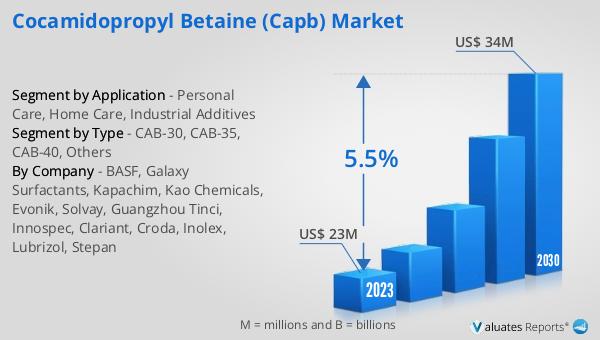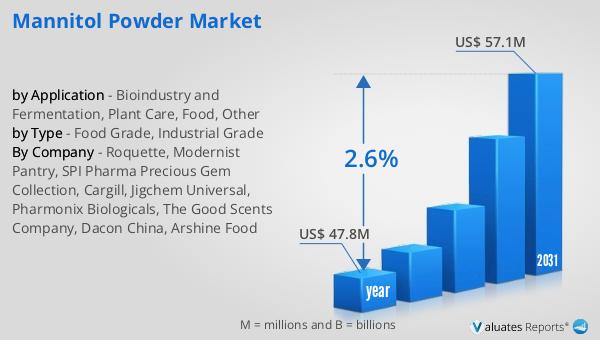What is Global Cocamidopropyl Betaine (CAPB) Market?
The Global Cocamidopropyl Betaine (CAPB) Market is a significant segment within the chemical industry, primarily driven by its widespread use as a surfactant in various applications. CAPB is a naturally derived, amphoteric surfactant, which means it can act as both an acid and a base, making it highly versatile. It is synthesized from coconut oil and dimethylaminopropylamine, which gives it a unique ability to reduce surface tension in liquids, allowing them to spread more easily. This property makes CAPB an essential ingredient in many personal care and cleaning products, such as shampoos, body washes, and household cleaners. Its popularity is also due to its mildness and compatibility with other surfactants, which enhances the overall performance of formulations. Additionally, CAPB is known for its ability to produce a rich, creamy lather, which is highly desirable in consumer products. The market for CAPB is expanding globally, driven by increasing consumer awareness and demand for natural and sustainable ingredients in personal care and cleaning products. As a result, manufacturers are focusing on producing high-quality CAPB to meet the growing needs of various industries.

CAB-30, CAB-35, CAB-40, Others in the Global Cocamidopropyl Betaine (CAPB) Market:
CAB-30, CAB-35, and CAB-40 are different grades of Cocamidopropyl Betaine (CAPB) that vary primarily in their active content and viscosity, which influence their application in various products. CAB-30 typically contains around 30% active content, making it a standard choice for many personal care formulations. Its moderate viscosity and foaming properties make it suitable for use in shampoos, body washes, and facial cleansers, where it provides gentle cleansing and conditioning effects. CAB-30 is favored for its balance between performance and cost-effectiveness, making it a popular choice for mass-market products. CAB-35, on the other hand, has a slightly higher active content of around 35%, which enhances its foaming and thickening properties. This makes it ideal for use in products that require a richer lather and more luxurious feel, such as premium shampoos and body washes. The increased active content also allows for more concentrated formulations, which can be beneficial in reducing packaging and transportation costs. CAB-35 is often used in formulations where a higher performance is desired without significantly increasing the cost. CAB-40, with an active content of approximately 40%, offers the highest viscosity and foaming capabilities among the three grades. This makes it particularly suitable for high-end personal care products that demand superior performance and sensory attributes. CAB-40 is often used in formulations that require a dense, creamy lather and enhanced conditioning properties, such as luxury shampoos, conditioners, and body washes. Its higher active content also allows for more efficient formulations, which can contribute to sustainability efforts by reducing the overall amount of product needed. In addition to these standard grades, there are other specialized forms of CAPB available in the market, tailored for specific applications. These may include variants with different pH levels, salt contents, or additional conditioning agents to meet the unique requirements of certain formulations. For instance, some CAPB variants are designed for use in sulfate-free or low-sulfate products, which are increasingly popular among consumers seeking gentler, more natural alternatives. The choice of CAPB grade depends on several factors, including the desired performance characteristics, formulation requirements, and cost considerations. Manufacturers often work closely with formulators to select the most appropriate grade for their specific needs, ensuring that the final product meets consumer expectations for quality and performance. As the demand for natural and sustainable ingredients continues to grow, the market for CAPB and its various grades is expected to expand, driven by innovation and the development of new applications.
Personal Care, Home Care, Industrial Additives in the Global Cocamidopropyl Betaine (CAPB) Market:
Cocamidopropyl Betaine (CAPB) is widely used in the personal care industry due to its gentle cleansing and foaming properties. In personal care products, CAPB is a key ingredient in shampoos, conditioners, body washes, and facial cleansers. Its ability to produce a rich, creamy lather makes it highly desirable for consumers seeking a luxurious washing experience. Additionally, CAPB is known for its mildness, making it suitable for sensitive skin and baby care products. It helps to reduce irritation and dryness, providing a gentle yet effective cleansing action. In the home care sector, CAPB is used in a variety of cleaning products, including dishwashing liquids, laundry detergents, and all-purpose cleaners. Its surfactant properties allow it to effectively break down grease and dirt, making it an essential ingredient in household cleaning formulations. CAPB's compatibility with other surfactants enhances the overall performance of cleaning products, ensuring that they deliver superior cleaning results. Furthermore, its biodegradability and low toxicity make it an environmentally friendly choice for eco-conscious consumers. In industrial applications, CAPB is used as an additive in various formulations, including metalworking fluids, oilfield chemicals, and agricultural products. Its ability to reduce surface tension and improve wetting properties makes it valuable in these applications, where efficient spreading and penetration are required. CAPB also acts as a corrosion inhibitor, helping to protect metal surfaces from rust and degradation. In the agricultural sector, CAPB is used as a wetting agent and dispersant in pesticide formulations, improving the effectiveness of crop protection products. Overall, the versatility and performance of CAPB make it a valuable ingredient in a wide range of applications, driving its demand across multiple industries. As consumer preferences shift towards natural and sustainable products, the use of CAPB is expected to grow, supported by ongoing research and development efforts to enhance its properties and expand its applications.
Global Cocamidopropyl Betaine (CAPB) Market Outlook:
In 2024, the global market for Cocamidopropyl Betaine (CAPB) was valued at approximately $790 million. Looking ahead, this market is anticipated to grow significantly, reaching an estimated value of $1,137 million by 2031. This growth trajectory represents a compound annual growth rate (CAGR) of 5.4% over the forecast period. This upward trend is indicative of the increasing demand for CAPB across various industries, driven by its versatile applications and consumer preference for natural and sustainable ingredients. The personal care industry, in particular, is a major driver of this growth, as consumers continue to seek products that offer gentle cleansing and conditioning properties. Additionally, the home care and industrial sectors are contributing to the market expansion, as CAPB's effectiveness as a surfactant and its environmentally friendly profile make it a preferred choice for manufacturers. As the market evolves, manufacturers are likely to focus on innovation and the development of new applications to meet the growing demand for CAPB. This includes exploring new formulations and enhancing the performance of existing products to cater to the diverse needs of consumers and industries. Overall, the future of the CAPB market looks promising, with opportunities for growth and expansion across various sectors.
| Report Metric | Details |
| Report Name | Cocamidopropyl Betaine (CAPB) Market |
| Accounted market size in year | US$ 790 million |
| Forecasted market size in 2031 | US$ 1137 million |
| CAGR | 5.4% |
| Base Year | year |
| Forecasted years | 2025 - 2031 |
| by Type |
|
| by Application |
|
| Production by Region |
|
| Consumption by Region |
|
| By Company | Solvay, Evonik, BASF, KAO Chem, Galaxy Sur., Clariant, Inolex, EOC, Lubrizol, Croda, Huntsman, Stepan, Oxiteno (Indorama Ventures), Lonza, Enaspol, Flower's Songs, Guangzhou Tinci, DX Chem, Kapachim, Yeser Chemicals, Kawaken Fine Chemicals Co, Lion Corporation, Innospec, Zschimmer & Schwarz, Miwon Commercial |
| Forecast units | USD million in value |
| Report coverage | Revenue and volume forecast, company share, competitive landscape, growth factors and trends |
